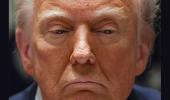'Reciprocal tariffs are not going to affect India except specific sectors and there are opportunities to capture.'

The United States' plan to impose reciprocal tariffs on its trading partners starting April 2 will create opportunities for India since Washington has slapped additional 20 to 25 per cent tariffs on countries such as China, Mexico, and Canada, according to a preliminary analysis prepared by the NITI Aayog.
China, Mexico, and Canada account for 50 per cent of the US' imports, which stand at over $3 trillion. They are India's main competitors in the American market.
"We are looking at the data at a disaggregated level ... these are preliminary results ... reciprocal tariffs are not going to affect (India) except specific sectors and there are opportunities to capture," NITI Aayog Programme Director Pravakar Sahoo said on Friday.
He did not elaborate on the sectors that might gain or lose due to the tariffs.
Since taking over as American president in January, Donald Trump has been bringing in protectionist policies to 'Make America Great Again'.
The US imposed 25 per cent import duties on steel and aluminium products on March 12 and a 25 per cent tariff on automobiles will kick in on April 3.
While Trump has stated that India, with its high tariff structure, would not be granted special treatment, he softened his stance in the past few days.
Without naming any country, he said a lot of countries would be given a break on April 2. He said tariffs would likely be more 'lenient than reciprocal'.
Trade report
The NITI Aayog has released the second edition of its Trade Watch Quarterly report, which looks at granular trade details in the July-September quarter this financial year.
The report highlights India's contribution to global trade is significant only in products which do not have huge global demand.
'The EU, Northeast Asia, North America, and ASEAN account for 77 per cent of global trade and 74 per cent of global imports, yet India's trade with these regions is only 8 per cent, and it caters to just 6 per cent of their import demand,' the report said.
India's exports of key commodities -- electrical machinery, mineral fuels, and nuclear reactors and mechanical appliances -- align with the region's top global imports, where China and the US are key competitors, with China being the leading supplier of electrical machinery and nuclear reactors.
India's share remains low at 1 to 2 per cent of these import baskets.
The Aayog said India held a 44 per cent trade share with South Asia, East Africa, and Southern Africa -- the regions that account for just 2 per cent of global trade.
'Top imported commodities of these regions are mineral fuels and nuclear reactors with India's key exports to these regions include natural and cultured pearls and mineral fuels, where Russia and the UAE are the leading competitors for mineral fuels,' it said.
With a focus on India's textile trade in this edition, the report said textile and apparel exports had remained stagnant at approximately $40 billion for the past six years, growing at just 0.8 per cent annually, which is significantly lower than the global growth rate of 3.5 per cent.
Feature Presentation: Ashish Narsale/Rediff.com












 © 2025
© 2025